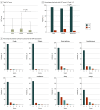Symptoms and Health Outcomes Among Survivors of COVID-19 Infection 1 Year After Discharge From Hospitals in Wuhan, China
- PMID: 34586367
- PMCID: PMC8482055
- DOI: 10.1001/jamanetworkopen.2021.27403
Symptoms and Health Outcomes Among Survivors of COVID-19 Infection 1 Year After Discharge From Hospitals in Wuhan, China
Abstract
Importance: The long-term health outcomes and symptom burden of COVID-19 remain largely unclear.
Objective: To evaluate health outcomes of COVID-19 survivors 1 year after hospital discharge and to identify associated risk factors.
Design, setting, and participants: This retrospective, multicenter cohort study was conducted at 2 designated hospitals, Huoshenshan Hospital and Taikang Tongji Hospital, both in Wuhan, China. All adult patients with COVID-19 discharged between February 12 and April 10, 2020, were screened for eligibility. Of a consecutive sample of 3988 discharged patients, 1555 were excluded (796 declined to participate and 759 were unable to be contacted) and the remaining 2433 patients were enrolled. All patients were interviewed via telephone from March 1 to March 20, 2021. Statistical analysis was performed from March 28 to April 18, 2021.
Exposures: COVID-19.
Main outcomes and measures: All patients participated in telephone interviews using a series of questionnaires for evaluation of symptoms, along with a chronic obstructive pulmonary disease (COPD) assessment test (CAT). Logistic regression models were used to evaluate risk factors for fatigue, dyspnea, symptom burden, or higher CAT scores.
Results: Of 2433 patients at 1-year follow-up, 1205 (49.5%) were men and 680 (27.9%) were categorized into the severe disease group as defined by the World Health Organization guideline; the median (IQR) age was 60.0 (49.0-68.0) years. In total, 1095 patients (45.0%) reported at least 1 symptom. The most common symptoms included fatigue, sweating, chest tightness, anxiety, and myalgia. Older age (odds ratio [OR], 1.02; 95% CI, 1.01-1.02; P < .001), female sex (OR, 1.27; 95% CI, 1.06-1.52; P = .008), and severe disease during hospital stay (OR, 1.43; 95% CI, 1.18-1.74; P < .001) were associated with higher risks of fatigue. Older age (OR, 1.02; 95% CI, 1.01-1.03; P < .001) and severe disease (OR, 1.51; 95% CI, 1.14-1.99; P = .004) were associated with higher risks of having at least 3 symptoms. The median (IQR) CAT score was 2 (0-4), and a total of 161 patients (6.6%) had a CAT score of at least 10. Severe disease (OR, 1.84; 95% CI, 1.31-2.58; P < .001) and coexisting cerebrovascular diseases (OR, 1.95; 95% CI, 1.07-3.54; P = .03) were independent risk factors for CAT scores of at least 10.
Conclusions and relevance: This study found that patients with COVID-19 with severe disease during hospitalization had more postinfection symptoms and higher CAT scores.
Conflict of interest statement
Figures
References
Publication types
MeSH terms
LinkOut - more resources
Full Text Sources
Medical
Miscellaneous



